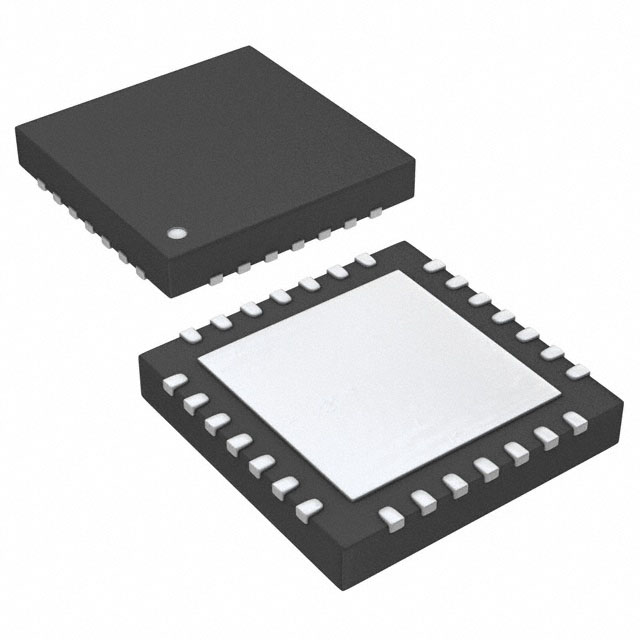Lihat spesifikasi untuk detail produk.

PIC16F1518-I/MV
Product Overview
Category
The PIC16F1518-I/MV belongs to the category of microcontrollers.
Use
This microcontroller is commonly used in various electronic applications that require embedded control and processing capabilities.
Characteristics
- High-performance 8-bit RISC architecture
- Flash program memory with self-read/write capability
- Low power consumption
- Wide operating voltage range
- Multiple communication interfaces (UART, SPI, I2C)
- Analog-to-Digital Converter (ADC) module
- Enhanced Capture/Compare/PWM (ECCP) module
- Timers and counters for precise timing operations
Package
The PIC16F1518-I/MV is available in a compact and durable package, suitable for surface mount technology (SMT). The package type is MV, which stands for Microchip's 28-pin QFN package.
Essence
The essence of the PIC16F1518-I/MV lies in its ability to provide efficient and reliable control and processing capabilities in a compact form factor.
Packaging/Quantity
This microcontroller is typically packaged in reels or tubes, depending on the manufacturer's specifications. The quantity per reel/tube may vary, but it is commonly available in quantities of 250 or 1000 units.
Specifications
- CPU Speed: Up to 32 MHz
- Program Memory Size: 14 KB
- RAM Size: 1 KB
- Number of I/O Pins: 25
- Operating Voltage Range: 1.8V to 5.5V
- ADC Resolution: 10-bit
- Communication Interfaces: UART, SPI, I2C
- Timers: 3 x 8-bit, 1 x 16-bit
- ECCP Modules: 2
- Operating Temperature Range: -40°C to +125°C
Detailed Pin Configuration
The PIC16F1518-I/MV has a total of 28 pins. The pin configuration is as follows:
- RA0
- RA1
- RA2
- RA3
- RA4
- RA5
- VSS (Ground)
- MCLR/VPP
- VDD (Power)
- RB0/AN12
- RB1/AN10
- RB2/AN8
- RB3/AN9
- RB4/AN11
- RB5/AN13
- RB6/PGC
- RB7/PGD
- RC0/T1OSO/T1CKI
- RC1/T1OSI/CCP2
- RC2/CCP1
- RC3/SCL
- RC4/SDA
- RC5/TX/CK
- RC6/RX/DT
- RC7/DT/CK
Functional Features
1. High-Performance RISC Architecture
The PIC16F1518-I/MV utilizes an efficient 8-bit RISC architecture, providing high-performance processing capabilities for various applications.
2. Flash Program Memory
With its self-read/write capability, the microcontroller allows for easy and flexible program memory management, enabling firmware updates and modifications.
3. Low Power Consumption
The microcontroller is designed to operate with low power consumption, making it suitable for battery-powered devices or energy-efficient applications.
4. Communication Interfaces
Multiple communication interfaces, including UART, SPI, and I2C, enable seamless integration with other devices and systems, facilitating data exchange and control.
5. Analog-to-Digital Converter (ADC) Module
The built-in ADC module allows for accurate and reliable analog signal conversion, making it ideal for applications that require precise measurements or sensor interfacing.
6. Enhanced Capture/Compare/PWM (ECCP) Module
The ECCP module provides advanced control capabilities, enabling the microcontroller to generate precise timing signals and perform complex pulse width modulation (PWM) operations.
Advantages
- Compact form factor suitable for space-constrained designs
- Wide operating voltage range allows for flexibility in power supply options
- Multiple communication interfaces facilitate seamless integration with other devices
- Low power consumption extends battery life in portable applications
- High-performance RISC architecture enables efficient processing and control operations
- Built-in ADC and ECCP modules provide enhanced functionality for various applications
Disadvantages
- Limited program memory size may restrict the complexity of firmware and application code
- Limited RAM size may impose constraints on data storage and manipulation
- Availability and pricing may vary depending on the supplier and market demand
Working Principles
The PIC16F1518-I/MV operates based on the principles of digital logic and microcontroller architecture. It executes instructions stored in its program memory, interacts with external
Sebutkan 10 pertanyaan dan jawaban umum terkait penerapan PIC16F1518-I/MV dalam solusi teknis
What is the maximum operating frequency of PIC16F1518-I/MV?
- The maximum operating frequency of PIC16F1518-I/MV is 32 MHz.Can PIC16F1518-I/MV be used for motor control applications?
- Yes, PIC16F1518-I/MV can be used for motor control applications with its integrated peripherals and PWM capabilities.What are the key features of PIC16F1518-I/MV?
- Key features of PIC16F1518-I/MV include 14 KB Flash program memory, 256 bytes of EEPROM data memory, and 256 bytes of SRAM.Is PIC16F1518-I/MV suitable for battery-powered applications?
- Yes, PIC16F1518-I/MV is suitable for battery-powered applications due to its low power consumption and sleep modes.Can PIC16F1518-I/MV communicate with other devices using I2C or SPI?
- Yes, PIC16F1518-I/MV supports both I2C and SPI communication protocols for interfacing with other devices.What development tools are available for programming PIC16F1518-I/MV?
- Development tools such as MPLAB X IDE and PICkit programmers are available for programming PIC16F1518-I/MV.Does PIC16F1518-I/MV have analog-to-digital conversion (ADC) capabilities?
- Yes, PIC16F1518-I/MV has a 10-bit ADC module for analog-to-digital conversion.Can PIC16F1518-I/MV be used in automotive applications?
- Yes, PIC16F1518-I/MV is suitable for automotive applications with its wide operating voltage range and robust design.Are there any application notes or reference designs available for PIC16F1518-I/MV?
- Yes, Microchip provides application notes and reference designs for implementing PIC16F1518-I/MV in various technical solutions.What are the available package options for PIC16F1518-I/MV?
- PIC16F1518-I/MV is available in various package options including QFN, SOIC, and DIP packages.

